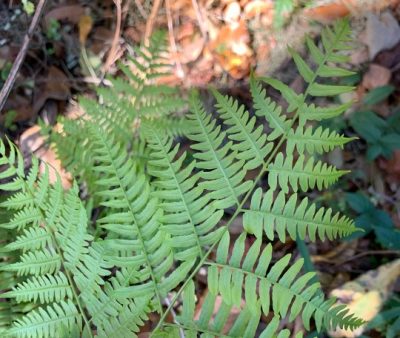
(Pteridium aquilinum) Photo: Claire Herzog
Ferns provide a variety of contributions to the ecosystems in which they exist. For example, they provide shelter, shade, erosion protection, chemical sequestration, and microhabitats that serve other species. In addition, there is also a high demand for ferns in the horticulture industry as they provide aesthetics to the cultivated landscape and make great houseplants with their lush fronds, air filtering capabilities, and are easy to maintain. Cut fronds are also sold in flower arrangements, utilized for dyes, fibers, crafts, medicine, and building materials.
Ferns are not a popular food item for animals. The fact that ferns lack flowers and seeds is a likely reason animals and insects are not enticed. Another factor is the defensive chemistry of most fern species. Vertebrates seem to avoid eating ferns with the exception of humans and the occasional white-tailed deer. Arthropods that are known to feed on ferns include aphids, whiteflies, caterpillars, mites, and crickets.
Some ferns produce secondary compounds that deter herbivores. Secondary compounds are biproducts of the main metabolic processes that can perform other functions. There are a number of ferns that produce human carcinogens as a secondary compound such as the bracken fern (Pteridium aquilinum). This species produces ptaquiloside, a highly water-soluble chemical that contains carcinogenic properties. Bracken fern is found throughout Florida and in many parts of the world. In Japan, young bracken fronds are boiled and pickled prior to consumption. Given the right preparation techniques, some harmful secondary metabolites can be reduced or eliminated, making it less toxic but still not entirely safe to eat.
Because of the importance to natural habitats as mentioned above, and their beauty, efforts should be made for their protection through land conservation and in botanical gardens through cultivation before many of them become endangered or even go extinct.
Awareness of native fern species is a great first step to contributing to their preservation. Taking the time to observe ferns in the ecosystem and bring awareness to their significant contributions to biodiversity will prolong their existence.
Please join us on our next BioBlitz this Presidents Day, February 21st 9am –12pm at Conservatory Park. This will be our last Finding Ferns EcoQuest as we conclude the month so we continue to focus on, but not limit our observations, to fern species.
Register Here: https://7082.blackbaudhosting.com/7082/Conservatory-Park-BioBlitz
Happy Finding Ferns!
The EcoFlora Team
